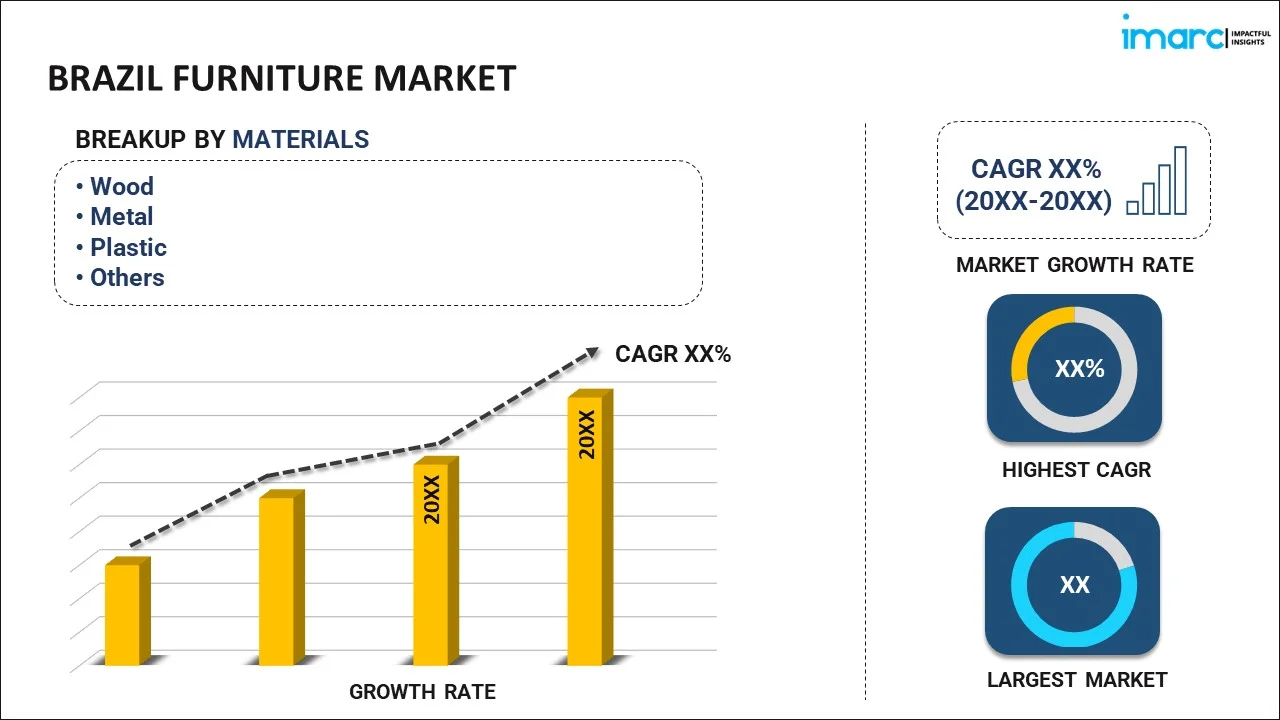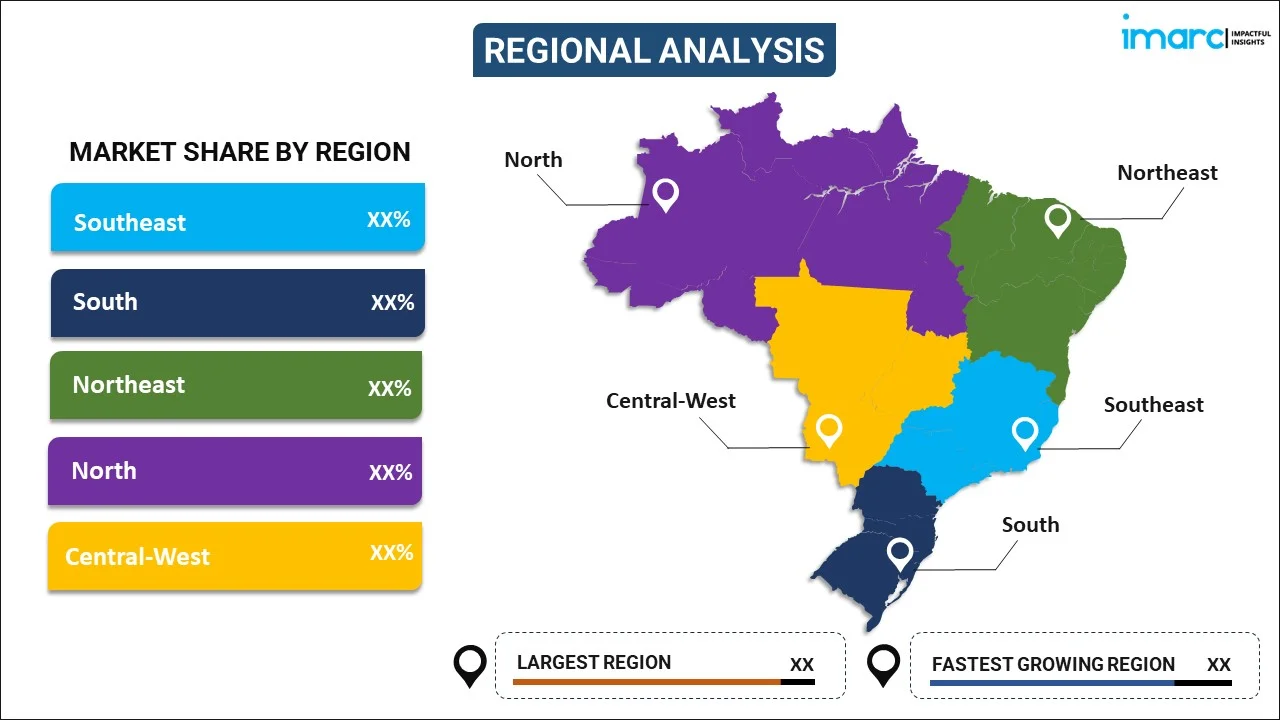
Brazil Furniture Market Report by Material (Wood, Metal, Plastic, and Others), Application (Home Furniture, Office Furniture, Hospitality Furniture, and Others), Distribution Channel (Supermarkets and Hypermarkets, Specialty Stores, Online, and Others), and Region 2025-2033
Market Overview:
Brazil furniture market size reached USD 15.0 Billion in 2024. Looking forward, IMARC Group expects the market to reach USD 25.1 Billion by 2033, exhibiting a growth rate (CAGR) of 5.45% during 2025-2033. The escalating demand for space-saving and multi-functional furniture, the easy availability of a wide range of furniture through online retail channels, and the widespread adoption of eco-friendly packaging practices represent some of the key factors driving the market.
|
Report Attribute
|
Key Statistics
|
|---|---|
|
Base Year
|
2024
|
|
Forecast Years
|
2025-2033
|
|
Historical Years
|
2019-2024
|
|
Market Size in 2024
|
USD 15.0 Billion |
|
Market Forecast in 2033
|
USD 25.1 Billion |
| Market Growth Rate 2025-2033 | 5.45% |
Furniture refers to movable objects that are designed to support various human activities. It includes chairs, tables, sofas, cabinets, and beds, typically used for seating, storage, or decorative purposes. It offers durability, aesthetics, and functionality, which can vary depending on its type and design. It provides improved comfort, organization, and aesthetic enhancement of living and working spaces. Besides this, it can also promote ergonomic support and contribute to a healthier and more productive environment. It is widely used in homes, including living rooms, bedrooms, kitchens, and dining areas. It is utilized as workstations, storage units, or specialized equipment for manufacturing and production. Moreover, as it protects documents and electronics from dust, theft, and fire, the demand for furniture is increasing across the corporate sector.
Brazil Furniture Market Trends:
Rising Middle-Class Expenditure:
Brazil’s middle class, representing nearly half of the country’s population, has seen a steady increase in disposable income, which is contributing to higher consumer spending across various sectors, including home improvement and furniture. The increase in consumer credit availability enables more households to invest in upgrading their living spaces. This increase in disposable income has allowed middle-class families to focus on improving home aesthetics, driving demand for furniture that is stylish and affordable. The trend reflects a shift in consumer preferences toward quality and comfort, with more Brazilians opting for furniture that enhances their homes’ functionality and appearance. The growth of retail finance options, such as installment plans, has also made it easier for middle-income families to afford furniture purchases. As the population continues to grow and spend more on home goods, the furniture market in Brazil is expected to benefit from sustained demand in the forecasted period.
Supportive Government Housing Programs:
Government initiatives like Casa Verde e Amarela are playing a significant role in increasing furniture demand in Brazil, particularly in the low-income housing segment. This housing program launched to provide affordable homes to families, has driven the need for low-cost, functional furniture to furnish these new homes. Moreover, the program creates a growing market for furniture retailers targeting this demographic by making housing more accessible to lower-income families. Along with this, several families are purchasing furniture for the first time, seeking affordable and durable options that fit within the limited space of government-supported housing units. The program’s focus on stimulating housing construction across urban and rural areas has a ripple effect on related sectors, including furniture manufacturing and retail. As more families move into new homes, the demand for basic furniture essentials such as beds, tables, and chairs are expected to increase, supporting Brazil's furniture market growth.
Significant Expansion of the E-Commerce Sector:
The e-commerce sector in Brazil has experienced rapid growth, particularly in the furniture market, where online sales increased. This expansion continues as digital infrastructure improves, making online shopping more accessible to consumers across the country. The convenience of browsing, comparing prices, and making purchases from home has driven many Brazilians to opt for online platforms when buying furniture. The rise of e-commerce has also allowed furniture retailers to reach a broader customer base, including those in rural or underserved areas. Retailers are increasingly offering flexible delivery options and virtual showrooms, further enhancing the online shopping experience. As consumers become more comfortable with online transactions and payment security improves, the trend toward purchasing furniture online is expected to continue. With growing internet penetration and the increasing adoption of smartphones, Brazil’s e-commerce sector will likely remain a major driver of growth for the furniture market.
Brazil Furniture Market Segmentation:
IMARC Group provides an analysis of the key trends in each segment of the market, along with forecasts at the country level for 2025-2033. Our report has categorized the market based on material, application, and distribution channel.
Material Insights:

- Wood
- Metal
- Plastic
- Others
The report has provided a detailed breakup and analysis of the market based on the material. This includes wood, metal, plastic, and others.
Application Insights:
- Home Furniture
- Office Furniture
- Hospitality Furniture
- Others
A detailed breakup and analysis of the market based on the application have also been provided in the report. This includes home furniture, office furniture, hospitality furniture, and others.
Distribution Channel Insights:
- Supermarkets and Hypermarkets
- Specialty Stores
- Online
- Others
The report has provided a detailed breakup and analysis of the market based on the distribution channel. This includes supermarkets and hypermarkets, specialty stores, online, and others.
Regional Insights:

- Southeast
- South
- Northeast
- North
- Central-West
The report has also provided a comprehensive analysis of all the major regional markets, which include Southeast, South, Northeast, North, and Central-West.
Competitive Landscape:
The market research report has also provided a comprehensive analysis of the competitive landscape in the market. Competitive analysis such as market structure, key player positioning, top winning strategies, competitive dashboard, and company evaluation quadrant has been covered in the report. Also, detailed profiles of all major companies have been provided. Some of the key players include:
- Artesano
- Dalla Costa Ltda
- Fábrica de Móveis Florense Ltda
- Linea Brasil
- Móveis Primavera
(Please note that this is only a partial list of the key players, and the complete list is provided in the report.)
Brazil Furniture Market News:
- In March 2024, Breton, a family-owned Brazilian brand renowned for luxury furniture design launched its first international showroom in Dubai. Spanning an impressive 2,300 square meters, the Dubai flagship store is situated in a high-end residential area along Al Wasl Road and occupies two floors.
- In February 2024, the Brazilian Furniture Project, initiated by the Brazilian Furniture Manufacturers Association (ABIMÓVEL) in collaboration with the Brazilian Trade and Investment Promotion Agency (ApexBrasil), generated over $35 Million at IMM Cologne 2024. The prospects for Brazilian firms were promising as they successfully elevated their brand presence on the international stage, facilitating networking opportunities and closing numerous business deals. The Brazilian brands at IMM 2024 showcased their innovative furniture and living solutions to a global audience, resulting in 648 business connections and generating over $21.39 Million in immediate and anticipated business over the coming year.
Brazil Furniture Market Report Coverage:
| Report Features | Details |
|---|---|
| Base Year of the Analysis | 2024 |
| Historical Period | 2019-2024 |
| Forecast Period | 2025-2033 |
| Units | Billion USD |
| Scope of the Report | Exploration of Historical Trends and Market Outlook, Industry Catalysts and Challenges, Segment-Wise Historical and Future Market Assessment:
|
| Materials Covered | Wood, Metal, Plastic, Others |
| Applications Covered | Home Furniture, Office Furniture, Hospitality Furniture, Others |
| Distribution Channels Covered | Supermarkets and Hypermarkets, Specialty Stores, Online, Others |
| Regions Covered | Southeast, South, Northeast, North, Central-West |
| Companies Covered | Artesano, Dalla Costa Ltda, Fábrica de Móveis Florense Ltda, Linea Brasil, Móveis Primavera, etc. |
| Customization Scope | 10% Free Customization |
| Post-Sale Analyst Support | 10-12 Weeks |
| Delivery Format | PDF and Excel through Email (We can also provide the editable version of the report in PPT/Word format on special request) |
Key Questions Answered in This Report:
- How has the Brazil furniture market performed so far and how will it perform in the coming years?
- What has been the impact of COVID-19 on the Brazil furniture market?
- What is the breakup of the Brazil furniture market on the basis of material?
- What is the breakup of the Brazil furniture market on the basis of application?
- What is the breakup of the Brazil furniture market on the basis of distribution channel?
- What are the various stages in the value chain of the Brazil furniture market?
- What are the key driving factors and challenges in the Brazil furniture?
- What is the structure of the Brazil furniture market and who are the key players?
- What is the degree of competition in the Brazil furniture market?
Key Benefits for Stakeholders:
- IMARC’s industry report offers a comprehensive quantitative analysis of various market segments, historical and current market trends, market forecasts, and dynamics of the Brazil furniture market from 2019-2033.
- The research report provides the latest information on the market drivers, challenges, and opportunities in the Brazil furniture market.
- Porter's five forces analysis assist stakeholders in assessing the impact of new entrants, competitive rivalry, supplier power, buyer power, and the threat of substitution. It helps stakeholders to analyze the level of competition within the Brazil furniture industry and its attractiveness.
- Competitive landscape allows stakeholders to understand their competitive environment and provides an insight into the current positions of key players in the market.
Need more help?
- Speak to our experienced analysts for insights on the current market scenarios.
- Include additional segments and countries to customize the report as per your requirement.
- Gain an unparalleled competitive advantage in your domain by understanding how to utilize the report and positively impacting your operations and revenue.
- For further assistance, please connect with our analysts.

 Inquire Before Buying
Inquire Before Buying
 Speak to an Analyst
Speak to an Analyst
 Request Brochure
Request Brochure
 Request Customization
Request Customization



.webp)




.webp)












